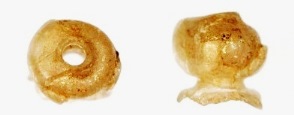New evidence of the power and reach of the Silk Road seems to be puzzling and mystifying scholars. Roman jewelry was recently found in in a Japanese tomb dating from the 5th Century ACE. Why this startles anyone is beyond me. The network of maritime and land traders that we now know as the Silk Road linked west and east as far back as 2000 years BCE when episodic trade between Afghanistan and China began for lapis lazuli and jade. Humans being human, news of beautiful, desirable or delicious things spread rapidly. In addition, migration, forced or voluntary (for economic reasons) was common and brought people together in unlikely combinations – Jews in China, Greeks in Timur’s Uzbekistan, Arabs in Venice, Chinese in Azerbaijan and Africa etc.
The discovery in question is three glass beads, each about 5 mm in diameter that are clearly of Roman manufacture – showing the layered glass and gilt technique common in the empire as well as natron in the manufacture of the glass. In the photos above, it is easy to see the layering – especially in the bead on the right. The flecks of gold gilt are evident on both. Beautiful indeed. One can see why they were precious even in Japan, far away from their point of manufacture.
Tests run by the Nara National Research Institute for Cultural Properties have revealed three glass beads discovered in the Fifth Century “Utsukushi” burial mound in Nagaoka, near Kyoto, were probably made in Rome sometime between the first and the fourth century ACE.
How, exactly, the beads got to Japan is not known? They could have been recent purchases, or heirlooms handed down from parent to child for centuries before their burial, or they could have come to Japan along with the many Chinese and Korean immigrants who became naturalized Japanese and held important positions at the Yamato court during the Kofun period (250-538 A.D.). The tomb itself dates back to the Yamato period of Japanese history, an era marked by inter-provincial warfare when the Imperial capitol was located in Nara.
But to be sure, the Silk Road complex of trading networks on sea and land that ran from Europe through Africa, Arabia, Persia, India, China, and Korea to Japan and back again was how they traveled from Rome to Japan. Traders did local legs of the massive voyage, stopping at market cities to sell their goods which would then be traded again a little further away and so on, until silk from China wound up adorning Roman emperors and Roman gold-flecked glassware jewels ended up the prized possession of a 5th century Japanese nobleman. (Words by Laura Kelley. Photos by Nara National Research Institute.)

